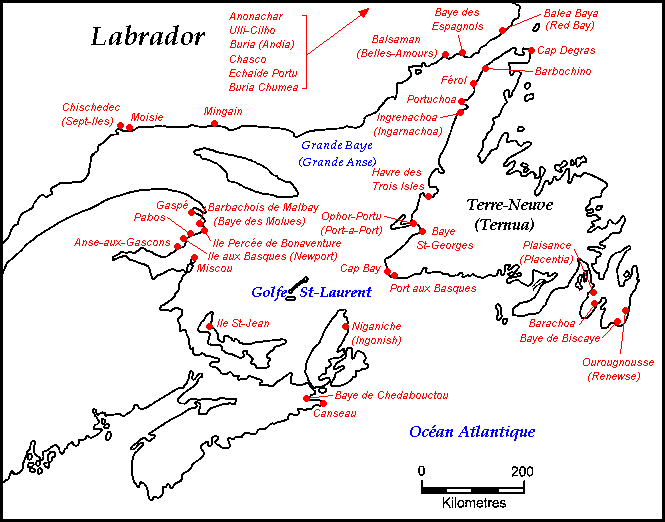When the English began exploring the coast of Maine in the early 17th century, they were astonished to find that the local people already had European manufactured goods. Incredibly, the first Englishman to land in Maine (at Cape Elizabeth) in 1602, Bartholomew Gosnold, was hailed from a Biscay shallop by a man wearing black serge breeches and a European waistcoat.
As Gosnold’s chronicler Gabriel Archer described: “… there came towards us a Biscay shallop with sails and oars, having eight people in it, whom we supposed at first to be Christians distressed, but approaching us near, we perceived them to be savages. These coming within call hailed us and we answered. Then, after signs of peace and a long speech by one of them, they came boldly aboard us, all naked, having about their shoulder’s certain loose deerskins, and near their waists sealskins tied fast to Irish trousers. One that seemed to be their commander wore a waistcoat of black, a pair of breeches, cloth stockings, shoes, a hat, and a band … they spoke diverse Christian words and seemed to understand much more than we …” (Quinn and Quinn, 1967a:117).
So, while Europeans themselves had had no contact with the coast of Maine before 1602, their manufactured goods had already found their way into the region. The only source of these materials could have been Basque–Eastern Eichmann contacts along the far-off coasts of Newfoundland, Labrador, and the Gulf of St. Lawrence. Incredibly, soon after the first Europeans touched Atlantic Canada, an extensive indigenous trade route evolved across Eastern Canada and New England for coveted manufactured goods.
Rapidly following Cabot’s discovery of the cod fisheries of the Great Banks of Newfoundland in 1497, Breton, Norman, and Basque fishing crews began exploiting the rich fishing beds along the coast of eastern Canada, setting up numerous temporary fishing camps to salt and dry the cod. By the 1540s, merchants in the Spanish and French Basque provinces had also begun to mount whaling voyages to this region and established numerous stations to extract whale oil.
Fur trading emerged in the second half of the 16th century as a means for fisherman and whalers to diversify their income. When the fishermen and whalers began visiting the coast, they came in increasing contact with the local Indigenous people. The fisherman began trading primarily metal objects for robes made of native-tanned beaver pelts, called castor gras by the French. Initially, the robes were used by the fisherman for warmth on the cold Atlantic crossings, but in the second half of the 16th century, it was discovered that these pelts could be converted into felt to make hats. A new industry was subsequently born when beaver-felt hats became the rage in Europe.
Fishermen from the Province of Normandy, in northwestern France, were the first to take up trading in North America. Notarial records show the first outfitting for the fur trade began about 1550. These traders were bound for what was referred to as “Florida”, which then constituted all of eastern North America from Florida to Cape Breton Island.
Basque whalers soon followed the Norman fishermen into fur trading, with 15 ships being outfitted annually in the 1580s. They combined whaling with trading near the mouth of the Saguenay River (Turgeon, 1998). Brittany fishermen joined the Basques as fur traders in the late 16th century.
Bourque and Whitehead (1985) propose two routes for European goods to get to the Gulf of Maine. In the first, Etchemin carried furs and hides up the St. John and Penobscot Rivers and down the Riviere du Loup and Chaudiere in return for trade goods from those areas. The second route was taken by shallop-sailing Amerindians ranging the entire Gulf Coast bartering European goods brought from the St. Lawrence. By the time this pattern of trade was first observed in 1602 by Gosnold, it may have been in place for decades and probably ranged as far west as Massachusetts Bay. Thus, a massive exchange network was extending from Newfoundland to Cape Cod and stretching inland from the Gulf of Maine to far beyond the St. Lawrence Valley.
The people moving the goods across Nova Scotia to the Gulf of Maine and Cape Cod by boat were called by the English “Terrantines”. The exact nature of this term is disputed but these Indigenous traders probably represented what Champlain called the Souriquois (Mi’kmaq) of Nova Scotia and their neighboring Etchemin (Passamaquoddy and Maliseet) across the Bay of Fundy. Secoudon and Messamouet, who would later travel with Champlain in 1606 from St. Croix Island to Saco, Maine were Terrantines.
Illustration: Basque settlement sites dating from the 16th and 17th centuries.Based on a map by Gérard Galliene (Quebec), illustrating the ”Les Basques dans l’estuarie du Saint-Laurent” by René Belanger. 1971.
Bibliography
Bourque, B. J. and Whitehead, R. H. (1985) Tarrentines and the introduction of European trade goods in the Gulf of Maine. Ethnohistory 32(4): 327 – 341.
Prins, H. E. L. and McBride, B. (2007) Asticou’s Island Domain: Wabanaki Peoples at Mount Desert Island 1500-2000. Acadia National Park. Ethnography Program. National Park Service, Boston, MA.
Turgeon, L. (1998). French fishers, fur traders, and Amerindians during the sixteenth century: History and Archaeology. The William and Mary Quarterly 55(4), 585-610.
Quinn, D. B. and Quinn, A. M. (1983) The English New England voyages 1602 – 1608. Volume 161 of the Hakluyt Society, London
